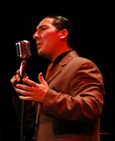About Tango Argentino

The Argentine tango came into being at the end of the 19th century in the immigrant districts of Buenos Aires and Montevideo on the Rio de la Plata. A tradition built up over more than a century has become ever livelier and inspired people not only in the homeland Argentina but also in Europe and Japan. This tango is a passionate and melancholic expression of a yearning for life, love and death, and has very little in common with the tango commercialised as pop entertainment and dance in Europe.
Its roots are all but obscured in the mists of time, in the poor suburbs populated by disappointed immigrants with illusory expectations of a better life, arriving in hordes from all parts of Europe, though mainly Spain and Italy. The tango emerged as a distinct folk dance and song as a result of the fusion of different rhythms, sounds and dances drawn from the cultures of African slaves, the suburban and rural population and the accelerating influx of immigrants from Europe. "Tango is a sad thought you can dance to", so said the poet Enrique Santos Discépolo.
At that time the tango was the dance of the lower class, at home in dockland bars and a brothel scene flourishing under the male-dominated immigrant social structure. Then, as a result of the rising status of immigrants and the success of the tango in Europe in the 1920s - 1930s, the dance entered Buenos Aires high society. The latter was totally committed to the adoption of any fashions arriving from Paris, so the tango was now welcome in smart company at home.

The most famous performer and indeed icon of the time was the singer Carlos Gardel, revered even today almost like a saint. After his death in 1935, the tango blossomed right through till the end of the 1940s, with no sign of withering to this day. At that time some 600 orchestras played in the various saloons, accompanying a devotion to and refinement of the expressiveness of the dance reaching such a level that it would be fair to describe it as indeed the most complicated of all folk dances. You can learn the basic principles quickly, but to perfect it you need a lifetime.
At the start of the 1950s its development stagnated, but Astor Piazzolla brought about a revival in the 1960s. Through contact with jazz and avant-garde style influences, the tango explored new directions and transformed itself from being folk and dance music into performing art and concert music, the tango nuevo. Osvaldo Pugliese, who developed his own unmistakable style, and Aníbal Troilo kept the traditional tango alive, their artistry developing it within its firmly staked-out territory toward new levels of expression.
For some years now, the Argentine tango has been experiencing a spectacular renaissance, not only in its homeland and onetime strongholds of Paris and Berlin. As a result of its widespread distribution, we now stand at the threshold of big new developments. Touring Argentine shows like "Tango Argentino", "Tango Pasión" and "Tango x2" have enjoyed huge international success.